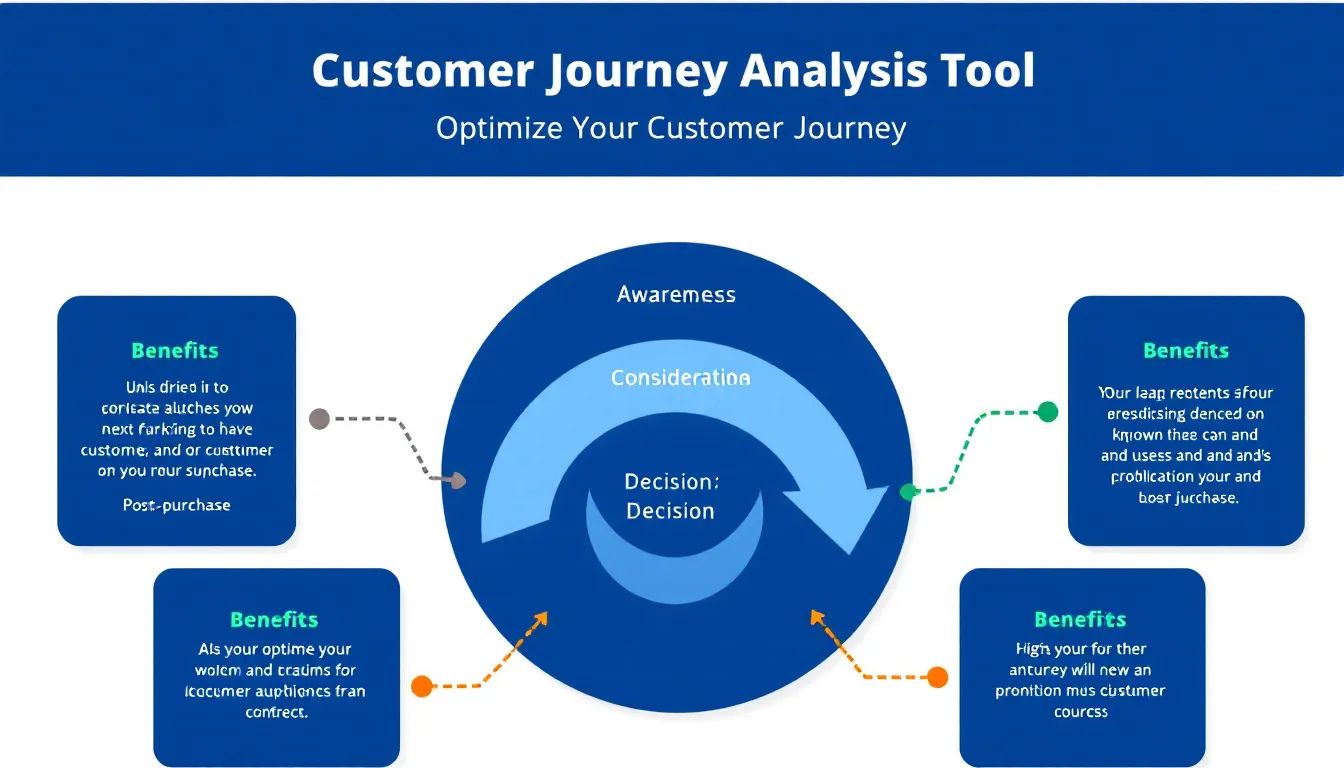Is this tool helpful?
How to Use the Customer Journey Analysis Tool Effectively
To get the most from this customer journey analysis tool, carefully fill in each section with precise and relevant information about your business. Here’s how you can approach each field:
- Company Name: Enter your company’s full legal name. For instance, use “BrightFuture Technologies LLC” or “OceanView Marketing Solutions”.
- Product/Service Description: Provide a detailed overview of what you offer. Examples: “Cloud-based project management software tailored for construction teams” or “Organic skincare products targeting sensitive skin”.
- Target Market: Define your ideal customers precisely. Examples include “Small business owners in the Midwest with 10-100 employees” or “Millennial consumers aged 25-35 interested in eco-friendly lifestyles”.
- Competitors (Optional): List your key competitors and what they offer. This could be “TechNova Innovations – user-friendly SaaS solutions” or “GreenGlow Naturals – locally sourced organic products”.
- Customer Pain Points (Optional): Describe any challenges your customers commonly face. For example, “Difficulties integrating software with legacy systems” or “Long wait times for customer support responses”.
What Is the Customer Journey Analysis Tool and Why Use It?
The Customer Journey Analysis Tool helps you understand how customers interact with your business at every stage—from first hearing about your brand to post-purchase activities. It highlights pain points and uncovers opportunities where you can stand out from competitors. By providing detailed insights, the tool guides you on improving customer experience and boosting your business success.
Purpose and Benefits
- Identify critical touchpoints: Understand each interaction your customer has with your brand, product, or service.
- Pinpoint pain points: Discover where customers struggle or drop off during their journey.
- Explore differentiation: Find market gaps where you can offer unique value.
- Optimize marketing efforts: Focus your resources on high-impact areas of the customer experience.
- Enhance conversion rates: Remove friction points that prevent customers from completing purchases.
Practical Uses of the Customer Journey Analysis Tool
This tool is designed to support businesses in making informed decisions by revealing detailed customer insights. Here are key practical applications tailored to various industries and business models:
E-commerce Optimization
An e-commerce business can use this tool to analyze where shoppers abandon their carts or hesitate in the purchase process. For instance, you might discover that complex checkout forms cause drop-offs. Simplifying these forms improves sales and customer satisfaction.
Service Industry Improvement
Businesses offering services can identify delays or frustrations in booking, consultation scheduling, or payment processes. This insight helps streamline operations to boost client retention and referral rates.
B2B Strategy Enhancement
B2B companies can leverage the tool to map decision-maker journeys, highlighting where prospects hesitate during demos or approval stages. Addressing these pain points accelerates the sales cycle.
Customer Support Focus
By detailing customer frustrations and service bottlenecks, you can prioritize improvements in support systems, reducing wait times and increasing customer loyalty.
Key Features and Capabilities of the Tool
Comprehensive Customer Journey Mapping
- Track stages from awareness and consideration through decision and post-purchase engagement.
- Identify emotional triggers and decision factors impacting customer behavior.
Competitive Differentiation Insights
- Analyze competitors’ strengths and weaknesses in your target market.
- Discover unique selling points that differentiate your offerings.
Pain Point Identification and Prioritization
- Detect frequently occurring customer challenges.
- Pursue improvements that yield the highest impact on satisfaction and revenue.
Maximizing Results with Customer Journey Analysis
Data-Driven Decision Making
Use the insights gathered to guide strategic initiatives such as product development, marketing campaigns, and customer support enhancements. Prioritize actions based on clear evidence of customer needs.
Cross-Functional Collaboration
Engage teams from marketing, sales, product, and customer service to interpret findings and implement solutions together. This ensures a holistic approach to improving the customer experience.
Regular Review and Refinement
Update your customer journey analysis frequently to capture changing customer behaviors and market dynamics. Continuous improvement drives sustained business growth.
Frequently Asked Questions About Customer Journey Analysis
How often should you perform a customer journey analysis?
Conduct a full analysis quarterly and monitor key customer interactions monthly to stay responsive to evolving needs.
Can this tool support both B2B and B2C companies?
Yes. The tool adapts to different business models by allowing you to tailor inputs based on your specific target audience and industry.
What makes your analysis successful?
Accuracy and completeness are crucial. Provide precise company, product, and market details, and honestly report customer pain points.
How can you use analysis results effectively?
Share results with stakeholders, create clear action plans focused on priority areas, and track improvements after implementing changes.
Should customer segments be analyzed separately?
Yes. Different segments often have distinct journeys and challenges. Segment-specific analysis increases relevance and impact.
Best Practices for Implementing Customer Journey Analysis
Collect Comprehensive Data
- Include detailed competitor profiles.
- Document every customer interaction point.
- Gather both numbers and customer stories.
- Update your data regularly to capture trends.
Collaborate Effectively
- Bring together diverse teams from your organization.
- Focus on actionable, measurable insights.
- Prioritize solutions by expected customer impact and feasibility.
- Monitor results after changes to confirm improvements.
Optimizing Performance with Customer Journey Insights
Continuous Improvement Cycles
- Update customer journey maps to reflect new insights.
- Refine your target market descriptions based on evolving data.
- Adjust your market positioning as competitors shift.
- Test and enhance your value propositions regularly.
Track Key Success Metrics
- Customer satisfaction and net promoter scores
- Conversion and retention rates at different touchpoints
- Customer lifetime value improvements
- Growth in market share within target segments
Important Disclaimer
The calculations, results, and content provided by our tools are not guaranteed to be accurate, complete, or reliable. Users are responsible for verifying and interpreting the results. Our content and tools may contain errors, biases, or inconsistencies. Do not enter personal data, sensitive information, or personally identifiable information in our web forms or tools. Such data entry violates our terms of service and may result in unauthorized disclosure to third parties. We reserve the right to save inputs and outputs from our tools for the purposes of error debugging, bias identification, and performance improvement. External companies providing AI models used in our tools may also save and process data in accordance with their own policies. By using our tools, you consent to this data collection and processing. We reserve the right to limit the usage of our tools based on current usability factors.







